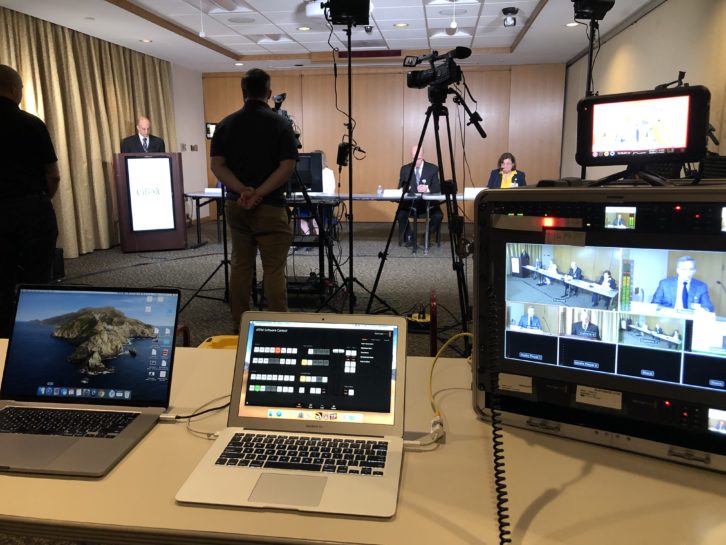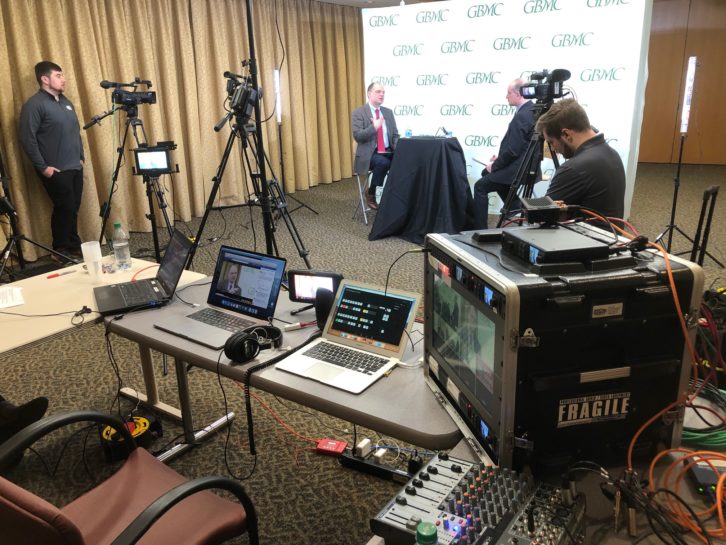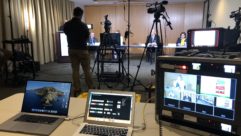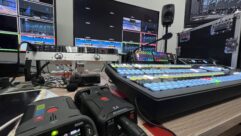On this edition of the SVC Podcast, Contributing Editor Bennett Liles completes his interview with Marty Jenoff, President of Focal Point Productions, about the new global emphasis on videoconferencing technology in the wake of the global pandemic. In Part 2 Marty details their Facebook live streaming for a public Covid-19 town hall for Greater Baltimore Medical Center and he provides tips for those trying to connect online by video. He also expresses some ideas on how the present crisis will affect the videoconferencing market.
FOR MORE: GO TO PART 1
Links:
- Focal Point Productions in Owings Mills, Maryland
- Teradeck Cube 605 H.264(AVC) Encoder
- Blackmagic HyperDeck Studio Mini
- Canon XF205 professional camcorder
- Shure MX418 Microflex gooseneck microphone
In the middle of a pandemic real time communication is vital. Focal Point Productions provided Covid-19 town hall meetings and Facebook Live streaming between hospital leaders and healthcare workers at Greater Baltimore Medical Center to get their questions answered. Company president Marty Jenoff wraps up his story on it next on the SVC Podcast.
Marty, good to have you with us, coming to us from Focal Point Productions in the Baltimore area. Glad to have you back.
Glad to be here again.
We were talking before about your partnership with Greater Baltimore Medical Center, the GBMC, in getting real time information out to and from the front line healthcare workers fighting the virus. One of your aims is to make a professional- looking video conference happen between, in some cases, non-tech people. How do you get your clients ready to participate in one of these internal GBMC Covid-19 town hall meetings?
Yeah. So when a client comes to us about doing any live stream, and in specific these town halls, we really want to go over with them and find out who is involved, who’s going to be there, how many people are talking? We find out that there’s going to be a moderator and four panelists so we needed to think about camera angles, audio, microphones, audio mixer, lighting. And then we wanted to find out what distributing platform will we use. In this case they wanted to use Cisco’s WebEx. And then we also wanted to find out how are they going to work with the question that come in? We had over a thousand people watching our last livestream, and as you can imagine we had a lot of questions and comments coming in. So really talking with the client to figure out how would that work? What is the flow going to be for questions coming in? And then how is the moderator going to go through them and then to decide which panelist to ask each question to. [Timestamp: 1:57]
That’s probably a little trickier since you’ve got more two-way interaction going on in the Covid-19 town hall meetings. Tell me about the Facebook Live streaming you’ve done for the medical center there.
So we did four or five Facebook Live streams for Greater Baltimore Medical Center in response to Covid-19 in the Baltimore community over the course of two days. We did four Facebook Lives and we did those on different topics, again related to Covid-19. One was on anxiety and depression. One was on heart health, diabetes, general questions related to Covid-19 – you know, how can you catch it, how can you protect yourself against it. And then we did one on weight loss for the bariatric weight loss support program. All those related to, again, Covid-19 and the community using Facebook Live. Each of them was done in a little bit of a different way based on the guest, the moderator, and the flow of how they wanted their shows to go. [Timestamp: 2:59]
And when you set up to do one of these things you do it at the hospital?
Yes. We did four of them at the hospital in their conference center and then we did one of them in our studio, which is about 20 or 30 minutes away from the hospital. [Timestamp: 3:13]
It was interesting hearing before about how you interface their conferencing system with yours because they do have some in-house conferencing capability.
Yeah. So they do livestream some of their own events from there. It’s using a ceiling-mounted static camera. They have microphones that drop down from the ceiling, so typically when they do things there the audio and video isn’t really great. That’s why they wanted to have us come in to do these town halls for them because it’s that important. So they wanted to bring in a vendor to just kind of take it off them to make sure that people watching it were getting a good viewing experience and that they could see and hear everything well. So the good thing for us was we did these town halls and the Facebook Lives all in the same room. So we knew the room well. We know lighting concerns. Where are the power outlets; how many power outlets are there? Where is the internet connection? Where do we park and unload the van from? All those things that we usually put into our site surveys, it was really easy because we’re in the same room for multiple days doing these different live broadcasts. [Timestamp: 4:23]

Of course, at this critical time, they want to be able to concentrate on the subject matter without the tech side getting in the way. How do they communicate on these events? Are there other ways that you can get questions from viewers?
So the livestreams, we receive questions in two different ways. The first was employees were able to submit their questions ahead of time via email or a web form that they would take to then give to the moderator. And then we also received a lot of questions live and in real time through the chatroom. For Facebook Live, same kind of thing. People were able to email in their questions ahead of time if they weren’t going to be able to watch it live, and then we also did get questions through Facebook in the comments section. And then again, the moderator would kind of take those and give them to the host in order that they wanted them to be presented. [Timestamp: 5:13]
So on Facebook streaming, they’re probably more familiar with this having done this with their friends online. I noticed that you used Blackmagic Web Presenter at the output of your stream. How did you use that?
So our client wanted to use Cisco WebEx for the Covid-19 town halls and what we use the Blackmagic Web Presenter to do is to get the HD signal out of our Blackmagic video switcher. We need to get that into the client’s computer and so that WebEx will recognize it to do the livestream. Normally when we’re doing a livestream we’re going to use one of our Blackmagic capture cards to get into our laptop to do a livestream. But because we’re at the hospital we’re unable to connect our computers to their network so we have to use their computer to do the livestream. And their computers are your typical corporate laptops or desktop computers. They don’t have thunderbolt connections. They can’t accept one of the high-quality Blackmagic Ultra Studio 4K signals. So we have to use the Blackmagic Web Presenter which takes, again, our SDI HD signal and converts it into USB and really tricks their computer into thinking that it’s a web camera. So WebEx will then recognize that USB signal and that web camera and we’re able to use our video switcher as the input into WebEx. That’s how we use the Blackmagic Web Presenter for the town halls and then we also used the Blackmagic Web Presenter when we did one of our Facebook Lives. We used that to get the video signal into one of our laptops, which we used to have our host via Skype. [Timestamp: 6:59]
So that just gets your signal into a friendlier format for them.
Exactly. So the Blackmagic Web Presenter is great because it works with any computer as long as it has a USB 2.0 connection. You can get professional video into any computer, Mac or PC. No drivers are needed. It’s plug-and-play and it works. So when we’re using someone else’s computer that we can’t install programs on it’s great because it just makes life so much easier. [Timestamp: 7:26]

Well, this is a great opportunity because you have so many non-tech people forced really, into connecting this way so what advice would you have as important points to remember for anyone trying to make virtual connections?
So my tips for someone that is trying to virtually connect with people, you know everyone now is doing Zoom meetings, WebEx meetings, Skype meetings, Google Hangouts – all these platforms that are out there. A couple of tips that I always give people are find a quiet room in your house. You don’t have a lot of background noise. You also don’t want to have a very busy background. You don’t want to have kids running behind you. You don’t want a bright window behind you. So pick your room wisely. If possible don’t use Wi-Fi. Try to use a plug-in hardwired internet connection. Try to use an external microphone. Don’t use your laptop’s built-in microphone. Use earbuds or headphones so that the speakers in your computer don’t echo back and get picked back up again by your microphone. And lastly, try to lift up your computer a couple inches so that the camera in the laptop is eye level so that the camera and the viewers aren’t looking up your nose counting your nose hairs or admiring your double chin or the ceiling in your bedroom. Lift up the camera so it’s eye level so that you’re looking straight out, not down. [Timestamp: 8:57]
Yes, on many of these the people look like giants you’re having to look up to see. The information that you provide for the Greater Baltimore Medical Center community is the latest and I’m sure you rely on the medical experts for the actual content while you handle the tech side.
Yeah. So we are the tech expert. The hospital has us come in to do all the techie stuff. I have no clue, really, a lot of times what they’re going to be talking about because the content is changing so quickly. We’ve had topics and their answers and responses change on a day-by-day basis. We let their medical experts, the host or the moderator, kind of do all the research and come up with scripts and a rundown and talking points. We try to not get in the way of that because it changes so quickly and we really try to focus on doing these livestreams and the technical aspect of it. And just like they don’t need to know about our end and the tech. We try to, in these cases, to kind of really separate the two. Normally when we’re doing a livestream we work together and I want to know the script and the rundown and the talking points. I get involved with clients a lot. But just because of this and the nature of the beast we really don’t cross streams that much. [Timestamp: 10:14]
Probably a central job of yours is just making sure all their graphics look right and are in the right format for the information they want to display visually.
Exactly. I’ll work with them to make sure, you know, if they want PowerPoint slides I’ll work to get that – to get a laptop to get that into the system. Like you said, lower thirds, full screens. If we’re doing Facebook Live getting the stream key and information and scheduling and setting up the Facebook Live and doing all that so that they don’t have to worry about it. [Timestamp: 10:43]
The current situation is unprecedented and I would think that it is going to have a profound long term effect on the videoconferencing market. What’s your take on that? What so you see coming for videoconferencing and live streaming now?
I think the market is going to explode. I think you’re already seeing that. I think we’re already seeing a big jump in people using Zoom, Skype, Google Hangouts; all those platforms. But I think in the weeks and months ahead when things get back to normal, I think people are going to find that they really liked having these virtual meetings. I think people may still be hesitant to get out in public. People will be hesitant to go to large meetings and conferences. And I think organizers and employers are going to look to live streaming to help them reach their audiences easily and effectively for a long time. I think livestreaming is going to see a huge jump in demand. [Timestamp: 11:44]
Especially as people get more comfortable with it and the apps get even more user friendly. People don’t want to be seen struggling with it but as it becomes more trendy perhaps that will really open the gates.
I think you’d be really hard-pressed to find someone in the U.S. that hasn’t used one of those livestreaming platforms – again, even FaceTime or whatever – it would be hard to find someone who hasn’t used one of those platforms in the last month or so. Everyone has used one of those platforms for personal or work reasons lately. [Timestamp: 12:15]
Very interesting prospects over the long term. It’ll be interesting to see what happens. We’ve been talking with Marty Jenoff, president of Focal Point Productions about their partnership with the Greater Baltimore Medical Center. Getting the word out in real time for healthcare workers at such a critical moment.
Thank you so much for having me. I hope it helps someone.
Videoconferencing is taking a quantum leap and Focal Point Productions has used its expertise to aim its power at the front line healthcare workers. Stay with us. We’ve got more stories coming up on how the power of the AV industry is being focused on this new invisible enemy. Those stories and more on the SVC Podcast.










